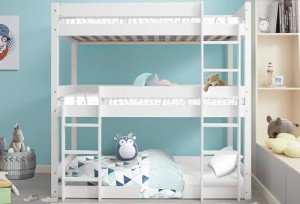Title: The Ultimate Guide to Kids Bunk Beds
Intro
As children grow, so does their need for area and storage services. Bunk beds are an excellent way to maximize area while supplying an enjoyable and practical sleeping plan for your kids. This comprehensive guide will check out the various types, advantages, security considerations, and FAQs connected to kids bunk beds.
I. Types of Kids Bunk Beds
- Requirement Bunk Beds: These are the most common type, featuring 2 twin-sized beds stacked on top of each other.
- Futon Bunk Beds: The bottom bunk is replaced with a futon, supplying a couch and a bed in one piece of furnishings.
- Twin-Over-Full Bunk Beds: The bottom bunk is larger, accommodating a full-sized mattress, while the leading bunk is a twin.
- L-Shaped Bunk Beds: These include 2 beds put perpendicularly, offering more floor area beneath.
- Loft Bunk Beds: A single bed is placed on a raised platform, leaving room for a desk, play area, or storage beneath.
II. Advantages of Kids Bunk Beds
- Space-Saving: Bunk beds are perfect for smaller bedrooms, freeing up flooring area for other activities and furnishings.
- Enjoyable and Exciting: Children often take pleasure in the novelty and adventure of climbing to their own private sleeping area.
- Cost-Effective: Purchasing one bunk bed is more budget friendly than purchasing two different beds.
- Versatile: Many bunk beds can be separated into two separate beds as children age or when area allows.
- Integrated Storage: Some bunk beds include built-in storage solutions, such as drawers, desks, or shelves.
III. Safety Considerations
- Tough Construction: Ensure the bunk bed is made from strong, resilient products and has a protected ladder for safe gain access to.
- Appropriate Spacing: Gaps between the bed mattress and the frame need to be less than 3.5 inches to avoid entrapment.
- Appropriate Height: Select a bunk bed with a proper height for your child, considering their age, size, and ability to climb and down securely.
- Secure Mattresses: Use the right size bed mattress and protect it to the bed frame to prevent it from shifting during sleep.
- Guardrails: Ensure guardrails are set up on both sides of the leading bunk and are at least 5 inches higher than the top of the bed mattress.
IV. Frequently asked questions
- What is the ideal age for a child to sleep on the leading bunk?It is normally recommended to wait up until a child is at least 6 years of ages before allowing them to sleep on the leading bunk.
- Can bunk beds be separated into 2 separate beds?Yes, some bunk beds can be taken apart and transformed into 2 separate beds.
- Just how much area is needed between the bottom of the leading bunk and the top of the bottom bunk? Cathie Mersman of 2 feet 8 inches is recommended for head clearance on the bottom bunk.
- Are bunk beds safe for children?When appropriately assembled and used, bunk beds are safe for children. Constantly follow security guidelines and guarantee your child comprehends the guidelines for utilizing the bunk bed.
V. Conclusion
Kids bunk beds are a practical and enjoyable option for optimizing area and supplying an unique sleeping experience for your children. By thinking about the numerous types, benefits, and security factors to consider, you can make a notified decision when picking the perfect bunk bed for your household.

